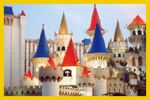






Water
 Most of the water, about 90 percent, used in the Las Vegas Valley comes from the Colorado River which creates a reservoir, Lake Mead, at Hoover Dam, 30 miles south-east of Las Vegas. The rest comes from aquifers (underground water).
Most of the water, about 90 percent, used in the Las Vegas Valley comes from the Colorado River which creates a reservoir, Lake Mead, at Hoover Dam, 30 miles south-east of Las Vegas. The rest comes from aquifers (underground water).
The water from the Colorado River has been allocated between seven states. The upper basis states are Colorado (51.75%), Utah (23%), Wyoming (14%), and New Mexico (11.25%). The lower basin states are California (4,400,000 acre-feet of water), Arizona (2,800,000), and Nevada (300,000). An acre-foot is the amount water covering one acre and one foot deep, or 326,000 gallons.
The average rainfall in Las Vegas is 4.7 inches per year.
The flash flood season is between July and September. Flash floods are created by heavy, sudden rainstorms. Avoid driving through flooded streets, and stay away from power lines and electrical wires in the event of a flood. Visit www.regionalflood.org for information about flood zones and washes. www.lvstormwater.com.
Tap water in the Las Vegas Valley is safe to drink; it exceeds the federal Safe Drinking Water Act requirements; see a complete analysis report at the Las Vegas Valley Water District's website and also tips on how to improve the taste of tap water.
Xeriscaping is desert landscaping using drought-tolerant plants. The Southern Nevada Water Authority offers incentives for homeowners who choose to convert their traditional landscaping, such as lawns, to xeriscaping.
The hotel industry, including their water attractions, uses only about eight percent of the valley's water supply. Gray water is reclaimed water from sinks, bathtubs, and showers and, after being cleaned, is used in lakes and fountains. Black water, the water and waste from toilets, is drained into the valley's sewers.